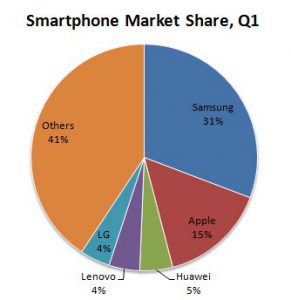 Thirty years ago, 1984, the recently announced alliance between Apple and IBM would have been all but inconceivable. In that year, Apple released its now-iconic ad campaign, ‘1984,’ branding IBM as stiflingly conventional. The Wall Street Journal, described it as: “painting IBM as a big-brother-like figure protecting the status quo while Apple’s Macintosh provided a pathway to freedom.”
Thirty years ago, 1984, the recently announced alliance between Apple and IBM would have been all but inconceivable. In that year, Apple released its now-iconic ad campaign, ‘1984,’ branding IBM as stiflingly conventional. The Wall Street Journal, described it as: “painting IBM as a big-brother-like figure protecting the status quo while Apple’s Macintosh provided a pathway to freedom.”
So, yeah, a partnership seemed impossible 30 years ago. But, not even a decade after the commercial, Apple and IBM entered into an alliance. Yes, they have tried this cooperation thing before. And no, it did not work out. Together they attempted to create a computer operating system to rival Microsoft Windows, which had lured much of the industry’s value away from both companies. This endeavor proved to be a waste of time and just three years after the companies agreed to work together, the partnership dissolved.
But, wait! There is more. Apple and IBM formed two other partnerships in the 1990s. One attempted to develop the technology to produce interactive CD-ROMs. It failed. The other, the AIM alliance, looked to build a platform to rival Intel’s personal computer. Although their competing PC failed, at least it had some positives. The PowerPC chip they produced during this partnership went on to run Apple’s Macs for several years. Well, until Apple decided it was time to change to new processors. And guess who built the new processors? Intel. Sorry IBM.
So will the fourth time be the charm? It just might. Today, there is a decided lack of competition between the two companies. The idea is that the final product will be something better than what each of the companies could have produced on its own. In this partnership, Apple and IBM have committed to producing more than 100 apps for specific business uses. So maybe, just maybe, this partnership can work
Month: July 2014
So, if you don’t know where to get started with a blueprint for your app, Rocket Farm Studios can take the pressure off.
Apple takes a shine to IBM
 Many are marveling at the new, powerful alliance between Apple and IBM. We are too.
Many are marveling at the new, powerful alliance between Apple and IBM. We are too.
Of course, the most interesting aspects of the deal are the capabilities IBM can give these devices in the corporate setting. Custom software for corporate teams, customized to what people do out and about in field service, retail, health care, and so on? That’s what this deal is really about.
But what does the move mean in the ongoing battle for mobile supremacy? Tech consultant Andrew Borg thinks it’s a defensive move by Apple, a response to concerns that Google has gotten stronger in the enterprise through its cloud services. But I don’t see it that way. Instead, I think it’s an offensive move to drive more Apple devices into the workplace and get iOS accepted by the CIO crowd as the standard business computing platform going forward — the true replacement for the once-dominant Blackberry.
First of all, let’s point out the obvious losers in this announcement: Blackberry and Microsoft. Blackberry was doomed anyways and the Apple-IBM announcement had pounded another nail in the coffin. And Microsoft, with its recent reorganization, is going to be dealing with a lot of contracting pain and reshuffling. In addition, Microsoft is in deep trouble in the mobile world and anyone who has used Google Docs or Apple’s Numbers/Pages/Keynote knows that there are very strong alternatives to Office and Windows. Microsoft: How fast will you shrink?
 That leaves a two-horse race between Apple and Google. Keep in mind that CIOs tend to base their buying decisions on two factors: security and homogeneity. This dynamic gives newly partnered Apple a clear edge. The Android platform has a reputation — not entirely undeserved — for security issues, so Apple has a clear advantage on that score. And with several different versions of Android operating on dozens of different devices, Google can’t compete on homogeneity either.
That leaves a two-horse race between Apple and Google. Keep in mind that CIOs tend to base their buying decisions on two factors: security and homogeneity. This dynamic gives newly partnered Apple a clear edge. The Android platform has a reputation — not entirely undeserved — for security issues, so Apple has a clear advantage on that score. And with several different versions of Android operating on dozens of different devices, Google can’t compete on homogeneity either.
So, if you are Mr. Big Company CIO you can figure out which version of Android to support and then which handset manufacturer to purchase from and then which device. Or you can just choose Apple. It seems that Apple, with its shiny new IBM partnership and a user base consistently running the latest OS, may just be the better choice.
So, if you don’t know where to get started with a blueprint for your app, Rocket Farm Studios can take the pressure off.
Microsoft partners up
From July 14th to July 17th our nation’s capital is playing host to Microsoft and its Worldwide Partner Conference. And, yes, #WPC14 is trending on Twitter. Though truly, it isn’t that surprising considering over 16,000 people attended the first day of the conference. So what is important about the 2014 conference?
 For one, Microsoft is continuing its evolution from a provider of on-premises software to a provider of cloud computing services and hardware devices. The uncertainty of a smooth transformation will potentially lead to fear in Microsoft’s partners. So how does Microsoft continue its transformation, while keeping all of the partners happy?
For one, Microsoft is continuing its evolution from a provider of on-premises software to a provider of cloud computing services and hardware devices. The uncertainty of a smooth transformation will potentially lead to fear in Microsoft’s partners. So how does Microsoft continue its transformation, while keeping all of the partners happy?
The perfect place to figure this out may be the Worldwide Partner Conference (WPC), which runs through Thursday in Washington, D.C. The event focuses on five areas — cloud computing, big data, mobility and devices, enterprise social software, and sales and marketing — all unified by Microsoft’s new mantra: “mobile-first, cloud-first.”
Unfortunately, Microsoft’s last stab at “mobile-first, cloud-first” was Windows 8. Which did not end so well. So this year, Microsoft plans to take all of its partners by storm, under the leadership of new CEO Satya Nadella. The plan is to refine its partner programs to be more aligned with its “cloud first, mobile first” philosophy.
 On Monday, the Microsoft Cloud Solutions Provider program was announced. A little background: Microsft blogger John Case, explains that after Microsoft announced its Office 365 Open program last year, the number of partners selling Office on Open grew 16 times year over year. But, “we also heard feedback that partners want to engage at every part of the customer lifecycle – from sales to renewal, from billing and provisioning, to support of their customers,“ Case wrote.
On Monday, the Microsoft Cloud Solutions Provider program was announced. A little background: Microsft blogger John Case, explains that after Microsoft announced its Office 365 Open program last year, the number of partners selling Office on Open grew 16 times year over year. But, “we also heard feedback that partners want to engage at every part of the customer lifecycle – from sales to renewal, from billing and provisioning, to support of their customers,“ Case wrote.
In simpler terms, partners wanted to be able to control the whole process. So this year, Microsoft is letting its partners do just that. This move is one step in the right direction towards keeping their partners happy while changing the company.
Step two? The company will also unveil three new programs aimed at Office 365 and Azure resellers. And according to PC World, Microsoft is also taking steps to motivate partners to resell Azure and Office 365, by waiving the first year fee to register as a Silver-tier provider and by increasing between 25 percent and 200 percent the number of internal-use rights (IUR) licenses available to them.
Will all of the changes and upgrades and announcements please Microsoft’s partners? That is hard to say. Microsoft caters to hundreds of thousands of heterogenous opinions. So, will they all like it? No one can be sure. All we know is that Microsoft is making an attempt at pleasing all that they can, while still taking on the “mobile-first, cloud-first” world that we live in.
So, if you don’t know where to get started with a blueprint for your app, Rocket Farm Studios can take the pressure off.
Living in a Material world
The digital world has no rules. Everything — features, color schemes, functionality — is allowed to behave in new and different ways. The lack of limits is exciting and surprising, but also stressful. Using a smartphone sometimes feels like a whole new adventure, but when you are trying to get something done, you don’t want to go on an adventure. You just want the predictable to happen. In order to solve this problem and make the use of smartphones more intuitive, Google has taken on a new perspective. They are diving in and attempting to assimilate programs in the phone to things in the outside world that humans already understand. Google is calling their solution Material Design.
Material Design, the new software language created by Google and presented in the Google I/O Conference, is more than just an idea about how software should work. It is a new idea about what software actually is. Google now defines software using the human mind as inspiration. The essence of the design is that all screens resemble paper. Paper in the physical world has shadows and can be turned around, moved and manipulated. The “paper” that Google has created also has shadows and can be moved. This “paper” is Google’s attempt at creating an intelligent material that can change and respond to touch in the organic way that the human mind understands, therefore making the use of a smartphone more intuitive.
To keep the design simple enough so that the human mind is satisfied, yet complex enough to complete all the functions that are necessary for a smartphone, Matias Duarte (Google’s VP of Design) and his team have two overarching solutions: Dimensionality and Motion.
Google uses the term ‘Dimensionality’ to describe a style in which shadows give graphic elements a sense of depth and elevation. When the user first touches the screen, a dot of color rises up, signaling you that you have in fact touched where you had intended to. Elements are layered on top of one another so the experience is consistent for users and developers do not have to worry about clashing styles.
The term ‘Motion’ is used by Google to highlight actions and changing interactive states. For example, on a list of music tracks, the only button that you will see in Material Design is the play arrow; when you hit the play arrow, it swoops down a little bit and turns into forward and reverse buttons, as well as volume control. This use of motion breaks apart the chain of action, and allows Google to then connect them with animations, overall giving more relevant inputs to each movement.
So how does Material Design factor in to the other announcements made at the Google I/O Conference 2014? Well, bringing Material Design to Android is a big part of the L-Release of Android. Google, the Software Sweet Shop explains, “We’ve added the new Material theme, which you can apply to your apps for a new style: it lets you easily infuse your own color palette into your app, and offers new system widgets, screen transitions and animated touch feedback. We’ve also added the ability to specify a view’s elevation, allowing you to raise UI elements and cast dynamic, real-time shadows in your apps.” Everything in Android L will use Material Design.
Material Design is intuitive and beautiful and…. elusive. Unfortunately, it seems that very few Android users will actually get to see Material Design. Innovation on the OS suffers from a lack of integration with the hardware makers, which means that Material Design, when it finally does make its way onto tablets and handsets, will likely be less fantastic than Duarte intended. Developers may potentially lose important pieces of the software when they begin tailoring it to their own devices because web and mobile teams tend to optimize the programs for their one particular problem. So, Duarte and his team are hoping that by communicating better with developers and documenting their design process in extreme detail, the system will at least be adapted, however slowly, in purer ways.
If Duarte and his team are able to successfully communicate each part of the process of Material Design like they hope to, sometime in the future, the new and exciting features of Material Design may actually make it onto your phone. This will no doubt take a while, as only 18 percent of users have even made it to Kit Kat up to this point. Once the Android developers catch up to the lovely Material Design, however, its intuitive new style may just revolutionize smartphones.
So, if you don’t know where to get started with a blueprint for your app, Rocket Farm Studios can take the pressure off.
Learning Swift-ly
As I mentioned last week, coding-tutorial maestro Ray Wenderlich has been moving, uh, swiftly to put out information about Apple’s newest programming language, Swift. After diving into his tutorials and playing with the new language myself, I have a few thoughts:
1. Apple is still stabilizing the language. With the Beta 3 release earlier this week, Apple is still making changes to the language (visit 9to5 Mac for a quick summary). Why is this move important? It simply reminds us that Swift is very, very new, and it will take some time for it to settle into its final form. In fact, one of Wenderlich’s Swift tutorials (How to Make a Game Like Candy Crush in Swift) was broken by Apple’s Beta 3 release because of the newest tweaks.
2. Swift has the potential to increase productivity. Developers can write more – and better – code with Swift. Let me get techy on you for a moment: Swift has a number of language constructs that make things even more bulletproof from the developer’s perspective, including strong typing, generics, containers, and more. And, because it’s strongly typed, Swift code should be faster, because there is less guess work about how the compiler can optimize. What’s that all mean for non-tech folks? Hopefully, better apps and more of them to choose from.
3. Swift will make it easier to learn. One of the key concepts of Swift is the playground – a console within Xcode where you can try out snippets of code. It’s a great way to experiment and try things before code gets popped into an app. Even more importantly, you can share playgrounds, making it easy to toy around with and share ideas. It’s a concept guaranteed to help new developers learn and push experienced coders into new realms of innovation and creativity.
Conclusions? Use Swift, keep an eye out for changes, and, most importantly, have fun.
So, if you don’t know where to get started with a blueprint for your app, Rocket Farm Studios can take the pressure off.
So you want to build an app
I get asked pretty often what’s the best place to start for someone who wants to learn how to develop mobile apps. My answer is always that there are two places to go if you want to learn.
The first place I send aspiring developers is Ray Wenderlich’s tutorial site. This site is, in a word, awesome. It has almost 500 tutorials, and each one is clearly written with plenty of screen shots and the accompanying code. Most of the tutorials are for iOS, but there are Android topics as well. Attached to each tutorial is a fully functioning project so you can instantly run the code and see it in action.
If you’ve never programmed before and terms like “Objective-C,” “strings,” and “arrays” mean nothing to you, you can start with the most basic instructions and work your way up. Already know the basics? Hone your skills with more advanced tutorials on adding animation, data storage, and many approaches to game development. There’s really no better way to learn than by reading a tutorial called “How To Make A Game Like Cut The Rope” (especially if, like me, you’ve spent far too many hours playing that very game).
The site is super-proactive about staying on top of the latest technologies, such as Apple’s new Swift language, which came out last month at WWDC. There are already eight tutorials on Swift, including an article that highlights the language from an Objective-C developer’s perspective.
Once you’ve got a few skills, you will find the site stackoverflow.com absolutely indispensable. Users with questions post their coding conundrums; users with answers post their solutions and vote for the answers they think are the most helpful. If you have a thorny technical issue you can’t solve, Stack Overflow is the place to go – invariably, someone else has had the same problem and it’s already been talked through and resolved.
Seasoned coders: What would you add to the list? Everyone else: What are you waiting for?
So, if you don’t know where to get started with a blueprint for your app, Rocket Farm Studios can take the pressure off.






